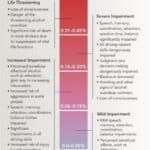What Is Bac?
BAC stands for blood alcohol content. BrAC stands for breath alcohol concentration. It is the metric used to measure the amount of alcohol intoxication, or alcohol percentage, in the blood. BAC and BrAC are primarily used for legal or medical purposes in the United States.
Blood Alcohol Level Myths
One big misconception about alcohol is that people can sober up by drinking coffee or eating to absorb alcohol. Neither is true. The only thing that will lower a person’s BAC is time. There is no way to dilute the amount of alcohol in the body by eating or drinking. However, alcohol absorption can be slowed by ingesting alcohol on a full stomach, but a person must have a full stomach prior to consuming the alcohol.
What Affects BAC?
A person’s BAC is affected by their gender, weight, metabolism, use of medications and rate at which they drink alcohol. For a full guide on the “ABCs of BAC” click here (NHTSA.gov PDF).
Gender
Men, on average, have a higher percentage of water in their bodies than women. This alone accounts for the fact that men have the ability to drink more alcohol than women before feeling impaired.
Weight
People who weigh more have more water in their bodies and thus, it takes more alcohol for them to become intoxicated.
Metabolism and other Genetic Factors
Metabolisms vary from person to person, depending on things like body temperature and the type of food and alcohol being metabolized. The slower the body metabolizes, the higher the BAC.
Medications
Certain medications, both prescription and over-the-counter, can enhance the effects of alcohol.
Rate of Consumption
The faster a person consumes alcohol, the higher their BAC. This BAC calculator from the Cleveland Clinic shows the relationship between alcohol consumed, time, and other factors to estimate BAC in different scenarios.
What is the legal limit for BAC?
The legal BAC limit for a DUI is .08 in every state in the U.S, except Utah, where it is .05. However, impairment begins at much lower levels. A good guide to the effects of various BAC levels can be found here, courtesy of the National Highway Traffic Administration.
Someone who has a .10 BAC has a 0.10% of total alcohol volume in their blood. That may not seem like much, but even .10 BAC is a lot of alcohol for the body to absorb. It takes much less to be intoxicated.
If you have an ignition interlock device in your vehicle then you cannot have a BAC above anything higher than zero.
Find out the legal limits in your state.
- At .02 drinkers will begin to feel warm and relaxed.
- At .04 people begin to feel more relaxed and talkative.
- At .05 people begin to feel mellow. The ability to drive safely becomes clearly impaired.
- At .06 a person’s judgment begins to become impaired.
That’s all before .08!
How Much Can You Drink Before Driving?
So how much do you need to drink to get to .08? As explained above, that depends on your gender, weight, metabolism, genetic factors, and use of medications and other intoxicating substances.
Some people can tolerate more alcohol than others. It’s important to never compare your consumption with someone else since every person is different.
The bottom line is to drink in moderation and always plan ahead with alternate transportation. Never wait until you have started consuming alcohol to decide on a safe ride home. Your judgment will have already been impaired.
LifeSafer is the best ignition interlock company to help you get back on the road if you’ve been convicted of a DUI. Learn more about ignition interlock information in your state.



